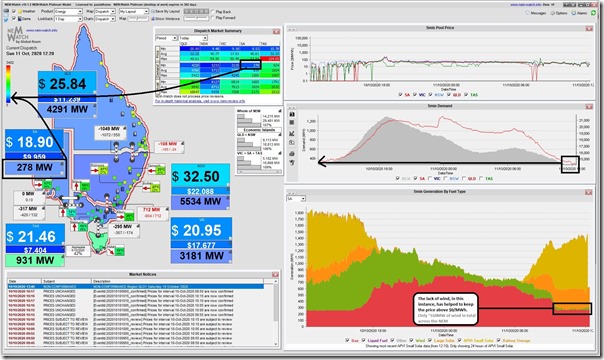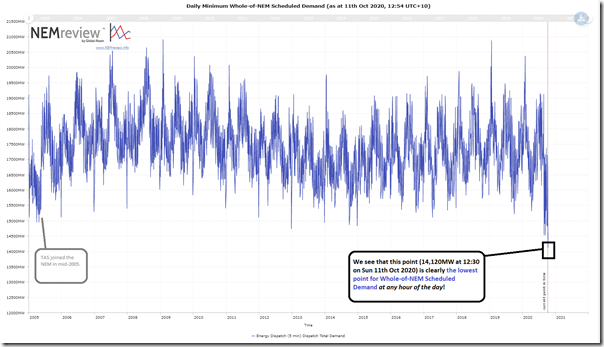An eagle eyed spotter helped me notice a new record low point in demand for South Australia today.
Here’s a snapshot from of the 12:20 dispatch interval from our NEMwatch v10 (entry-level dashboard) that shows the broader market situation:
Interestingly:
1) Scheduled Demand is in the well in the blue zone (i.e. down at the bottom of their respective historical ranges) in each of the mainland regions;
2) For each region:
(a) The South Australian region (with AEMO’s TOTALDEMAND figure at 278MW) is the lower than the (prior record) point of 315MW set on Sunday 13th September 2020.
(b) In Victoria, the point shown here (3,181MW) was still about 500MW above the low point of 2,690MW set on Sunday 6th September 2020.
(c) In NSW, the point here (5,534MW) is just under 500MW above the lowest point (5,050MW) stored inside NEMwatch and used to set the colours (which came at 03:35 on 26th December 2012 – so not yet superseded by the rise of rooftop PV in that region).
(d) In Queensland, the point shown here (4,291MW) was a little over 400MW above the low point of 3,889MW set on Sunday 27th September 2020.
… so three of four mainland regions have seen new record lows in the past 30 days or so. Is it any wonder that an increasing number of journalists are asking about the growing challenges of the rise of rooftop PV (and the AEMO devoted the largest chapter of the ESOO 2020 to it, as Allan noted).
3) It also means the Whole-of-NEM Scheduled Demand is also quite low. It is 14,215MW shown here – but dropped further to 14,120MW at 12:30, which is (using this trend query in NEMreview v7) seen to be a new lowest point for ‘whole of NEM’ … remembering that the early years of the NEM were before Tassie joined the NEM so are not ‘apples to apples’:
4) Finally, it’s interesting to also note that prices are actually positive this weekend … which would be due in large part to there being little wind output across the whole of the NEM (~550MW or so), with as low as only 11MW seen in South Australia. Because there’s little Non-Scheduled wind, it also means that ‘Operational Demand’ is down quite close to ‘Scheduled Demand’ (i.e. 300MW in the half-hour period ending 12:30 – and also very much a low-point record).
The escalating challenges of ‘minimum demand’ are fast approaching!




The changes to solar inverters in SA is really too little too late. There needs to be a rapid shift to making hot water services a dynamic load. This alone won’t be enough, but it solves two problems and is one of the only things that can be done quickly and cheaply.
Hot water service is too variable a load to be considered a solution.
I don’t understand what you mean by variable. If the HWS are mostly controlled centrally, via providers if need be, then on days of forecast very low demand, the HWS are controlled in such a way that bulk of the load is run during the period(s) of lowest demand. Based on historic use and knowledge of the ambient temperature a very good estimate of the total load and duration can be modelled. Controllers could be managed over 4G or WiFi and even monitor the load current.
In case of emergency on the grid, controller can switch on or off hot water systems.
There is approximately 200MW to 300MW of residential HWS that could be controlled.
The ‘nameplate’ capacity of the HWS is one thing, but there is no way of knowing what it’s ‘availability’ is.
I.e. how many will turn on, how long they will run etc. the nameplate 200MW might be 50MW one day and 199MW the next.
I agree it needs to be done, simple no cost change. But it’s not anywhere near a game changer.
Negative load should not be a showstopper. Inverters will simply need to operate as though they are on an AC coupled system. Provide primary frequency response and accept AGC requests to adjust output.
Domestic, commercial and grid-scale batteries, combined with synchronous condensors can provide sufficient inertia and any curtailed VRE are effectively ‘spinning’ reserve.
The difficulty will be in determining the price.
*AC-coupled microgrid.